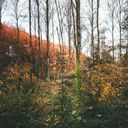
Chestnut (Castanea sativa), also known as Sweet chestnut or Spanish chestnut, comes from the Latin word "Castanea" originating from Asia Minor and the Caucasus region. It is a deciduous tree of the Fagaceae family. It produces fruit: chestnuts. When the trees are in abundance in a defined area, it forms a chestnut grove. In autumn, this foliage turns into a pretty yellow colour, which quickly turns brown. As with Oak and Beech, two trees of the same family, the leaves of Chestnut remain on the tree for part of the winter. This vegetation doesn't flower until after about twenty years.
- Growth: rapid
- Height: 30 meters
- Foliage: alternate, stalked, tough leaves with large, sharp teeth
- Trunk: straight, short and with a wide spread crown
- Bark: cracked lengthwise
- Color: dark brown

Explore EcoTree's unique approach to forestry, reforesting and how we give everyone a chance to own a piece of the forest.